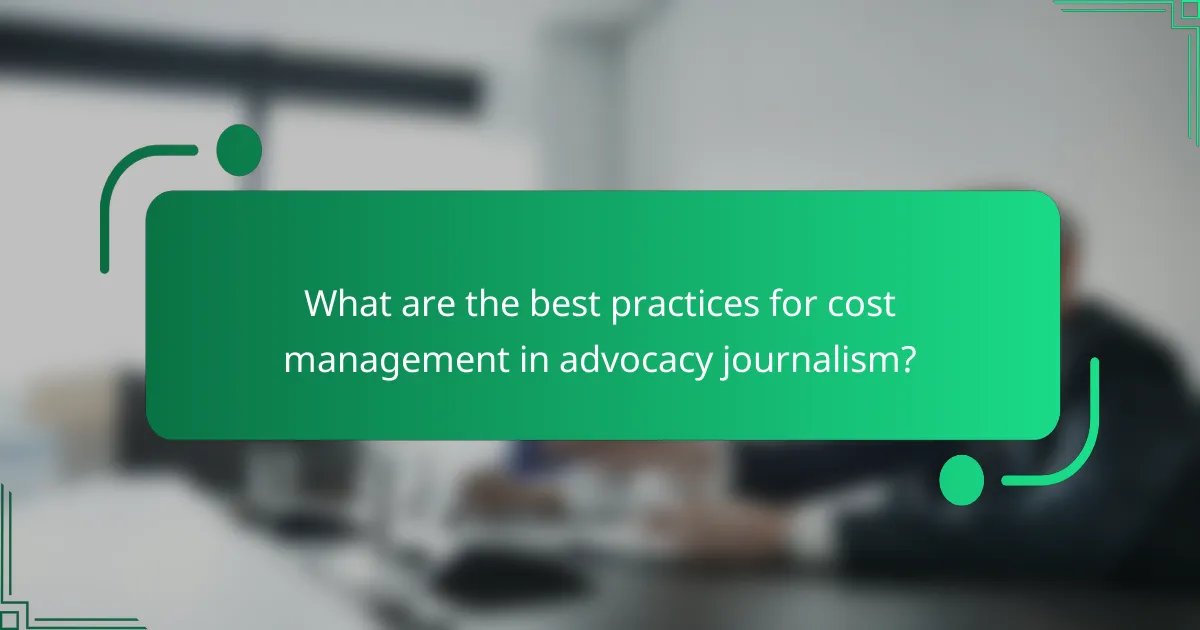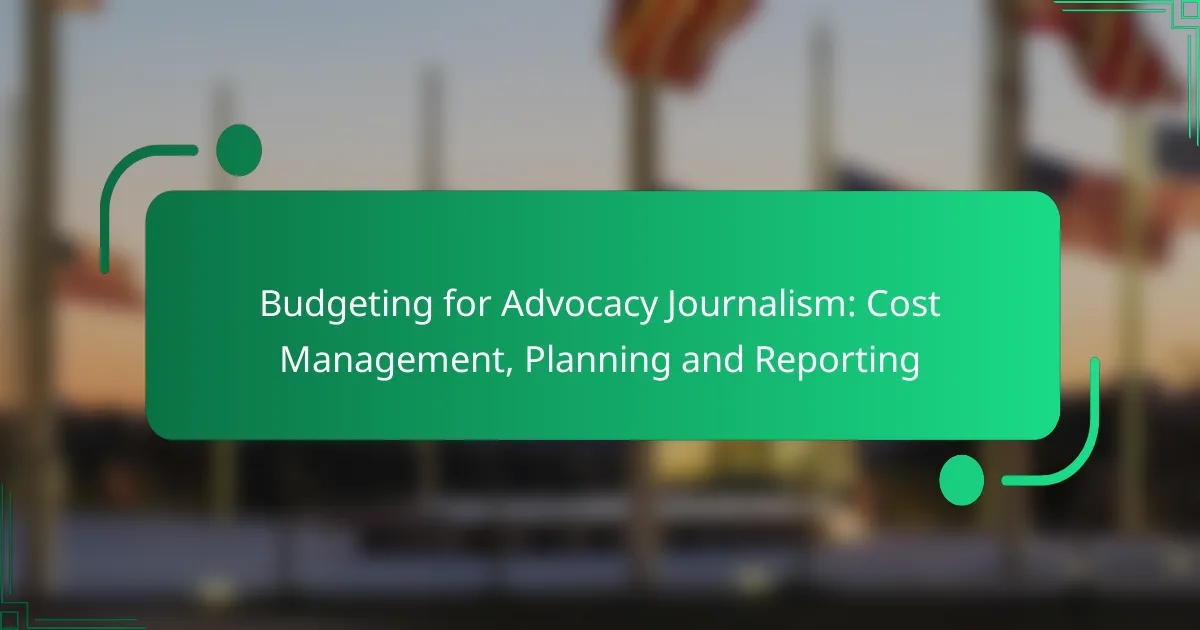Budgeting for advocacy journalism is crucial for producing impactful stories that foster social change. It requires careful planning and management of costs related to personnel, tools, marketing, and distribution, ensuring that resources are allocated efficiently to maximize influence on critical issues.

How to budget for advocacy journalism in the United States?
Budgeting for advocacy journalism in the United States involves understanding the unique costs associated with producing impactful stories that drive social change. Key considerations include identifying essential expenses, allocating funds for necessary tools, planning for personnel costs, and accounting for marketing and distribution efforts.
Identify key expenses
Start by listing all potential expenses related to your advocacy journalism project. Common costs include travel, equipment, software subscriptions, and freelance contributions. Prioritize these expenses based on their necessity and impact on your reporting.
Consider creating a spreadsheet to categorize these expenses into fixed and variable costs. Fixed costs might include salaries or long-term software licenses, while variable costs could encompass travel or freelance fees that fluctuate based on the project scope.
Allocate funds for reporting tools
Investing in the right reporting tools is crucial for effective advocacy journalism. This may include software for data analysis, content management systems, and communication tools. Allocate a portion of your budget specifically for these tools to enhance your reporting capabilities.
Research various options and consider free or low-cost alternatives that can still meet your needs. For example, platforms like Google Workspace offer collaborative tools at a reasonable price, which can be beneficial for team projects.
Plan for personnel costs
Personnel costs can be one of the largest budget items in advocacy journalism. This includes salaries for full-time staff, payments for freelancers, and benefits. Assess the skills required for your project and determine whether to hire in-house or contract out specific tasks.
When budgeting for personnel, consider the duration of the project and the level of expertise needed. For instance, hiring experienced journalists may cost more upfront but could lead to higher-quality reporting and greater impact.
Include marketing and distribution costs
Marketing and distribution are essential for ensuring your advocacy journalism reaches the intended audience. Budget for costs associated with social media promotion, email campaigns, and partnerships with other organizations. These efforts can significantly amplify your message.
Consider setting aside funds for both organic and paid marketing strategies. A balanced approach can help you maximize outreach while managing costs effectively. For example, using social media platforms can be a cost-effective way to engage audiences while also considering targeted ads for broader reach.

What are the best practices for cost management in advocacy journalism?
Effective cost management in advocacy journalism involves strategic planning, regular monitoring, and the use of appropriate tools to ensure financial sustainability. By implementing best practices, journalists can allocate resources efficiently while maximizing their impact on social issues.
Implement a detailed financial plan
A comprehensive financial plan is crucial for advocacy journalism as it outlines income sources, expenses, and funding goals. Start by identifying potential revenue streams such as grants, donations, and sponsorships, and estimate the costs associated with production, distribution, and marketing.
Consider creating a budget that categorizes expenses into fixed and variable costs. This helps in understanding where funds are allocated and where adjustments may be necessary. Regularly updating this plan will keep your financial strategy aligned with your advocacy goals.
Utilize budgeting software like QuickBooks
Using budgeting software such as QuickBooks can streamline financial management for advocacy journalism. These tools allow for easy tracking of income and expenses, generating reports, and providing insights into financial health.
Look for software that offers features tailored to non-profits or media organizations, such as grant tracking and donor management. This can save time and reduce errors, enabling journalists to focus more on their advocacy work rather than administrative tasks.
Regularly review and adjust budgets
Regular budget reviews are essential to ensure that financial plans remain relevant and effective. Set a schedule for monthly or quarterly reviews to assess spending against the budget and identify any discrepancies.
Be prepared to adjust budgets based on changing circumstances, such as unexpected expenses or shifts in funding. This flexibility allows advocacy journalists to respond to new opportunities or challenges while maintaining financial stability.

How to effectively plan advocacy journalism projects?
Effective planning for advocacy journalism projects involves setting clear objectives, developing a structured timeline, and engaging stakeholders from the outset. This approach ensures that resources are allocated efficiently and that the project aligns with its intended impact.
Set clear objectives and goals
Establishing clear objectives and goals is crucial for guiding your advocacy journalism project. These should be specific, measurable, achievable, relevant, and time-bound (SMART) to ensure clarity and focus.
For example, instead of a vague goal like “raise awareness,” specify “increase public awareness of environmental issues in the community by 30% within six months.” This precision helps in evaluating success and adjusting strategies as needed.
Develop a timeline for reporting
A well-structured timeline is essential for managing the various phases of your advocacy journalism project. Break down the project into key milestones, such as research, interviews, writing, and publication, and assign realistic deadlines to each phase.
Consider using project management tools or simple Gantt charts to visualize the timeline. This helps in tracking progress and ensuring that all team members are aligned on deadlines, which is particularly important when coordinating multiple contributors.
Engage stakeholders early in the process
Engaging stakeholders early in your advocacy journalism project can significantly enhance its effectiveness. Identify key individuals or organizations that have a vested interest in the topic and involve them in the planning stages.
For instance, if your project focuses on healthcare reform, include healthcare professionals, policymakers, and community leaders in discussions. Their insights can provide valuable context and help shape the narrative, ensuring that the final output resonates with the intended audience.

What reporting methods enhance transparency in budgeting?
Transparent budgeting in advocacy journalism relies on clear reporting methods that allow stakeholders to understand financial allocations and expenditures. Effective practices include open financial reporting and incorporating audience feedback mechanisms to foster trust and accountability.
Use open financial reporting practices
Open financial reporting practices involve making budgetary information accessible to the public, which can include detailed breakdowns of income and expenses. This transparency helps build credibility and allows stakeholders to see how funds are being utilized.
Consider using online platforms to publish financial reports regularly, detailing sources of funding, project costs, and any variances from the budget. For instance, a quarterly report could summarize expenditures against the planned budget, highlighting any significant deviations.
Incorporate audience feedback mechanisms
Incorporating audience feedback mechanisms allows stakeholders to voice their opinions on budget priorities and spending decisions. This can be achieved through surveys, public forums, or interactive platforms where audiences can ask questions and provide input.
To effectively gather feedback, consider setting up regular check-ins or feedback sessions after major reports are released. This not only engages the audience but also helps refine budgeting practices based on community needs and expectations, ultimately enhancing the relevance and impact of advocacy journalism efforts.

How to measure the impact of advocacy journalism spending?
Measuring the impact of advocacy journalism spending involves evaluating how effectively resources are used to engage audiences and achieve desired outcomes. This can be done through various metrics that reflect audience interaction and the results of funding sources.
Analyze audience engagement metrics
To assess audience engagement, track metrics such as website traffic, social media interactions, and email open rates. These indicators help determine how well your content resonates with the target audience and can guide future spending decisions.
Consider using tools like Google Analytics or social media insights to gather data. Aim for a consistent increase in engagement over time, which can indicate that your advocacy journalism is effectively reaching and influencing your audience.
Track funding sources and their outcomes
Monitoring funding sources involves keeping detailed records of where financial support comes from and how it translates into measurable outcomes. This includes analyzing grants, donations, and sponsorships to see which sources yield the best results for your advocacy efforts.
Establish clear metrics for success, such as increased awareness of issues or changes in public policy, and regularly review these outcomes against your spending. This practice not only ensures accountability but also helps in securing future funding by demonstrating the effectiveness of your journalism.

What are the challenges in budgeting for advocacy journalism?
Budgeting for advocacy journalism involves navigating various financial hurdles, including inconsistent funding and the need to maintain high-quality reporting. These challenges require careful planning and strategic management to ensure that resources are allocated effectively while achieving advocacy goals.
Managing fluctuating funding sources
Advocacy journalism often relies on diverse funding sources, such as grants, donations, and sponsorships, which can vary significantly over time. This variability necessitates a flexible budgeting approach that accommodates potential shortfalls or surpluses. Regularly reviewing funding commitments and diversifying income streams can help mitigate risks associated with fluctuations.
To effectively manage these funding sources, consider establishing a reserve fund that can cover operational costs during lean periods. This fund should ideally cover at least three to six months of expenses, allowing for smoother transitions when funding dips.
Balancing quality and cost
Maintaining high-quality journalism while managing costs is a critical challenge in advocacy work. Journalists must often weigh the benefits of thorough investigative reporting against budget constraints, which can lead to difficult decisions about resource allocation. Prioritizing stories that align closely with advocacy goals can help ensure that funds are used effectively.
One practical approach is to utilize a tiered budgeting system, where essential reporting activities receive priority funding, while less critical projects are scaled back or postponed. Additionally, leveraging partnerships with other organizations can provide access to shared resources, reducing individual costs while enhancing overall quality.

How can technology improve budgeting for advocacy journalism?
Technology can significantly enhance budgeting for advocacy journalism by providing tools for accurate tracking, analysis, and reporting of expenses. Digital platforms streamline financial management, enabling journalists to allocate resources effectively and adjust budgets in real-time.
Budgeting software options
Various budgeting software options cater specifically to the needs of advocacy journalism. Tools like QuickBooks, FreshBooks, and Wave offer features for expense tracking, invoicing, and financial reporting. These platforms can help journalists maintain transparency and accountability in their financial dealings.
Data analytics for cost management
Data analytics can play a crucial role in cost management for advocacy journalism. By analyzing spending patterns and project costs, journalists can identify areas for potential savings and optimize resource allocation. Utilizing analytics tools can lead to more informed decision-making regarding budget adjustments.
Collaboration tools for financial planning
Collaboration tools such as Trello, Asana, or Google Workspace facilitate teamwork in financial planning. These platforms allow teams to share budgets, track expenses, and communicate effectively about financial matters. Improved collaboration can lead to more cohesive budgeting strategies and better resource management.
Reporting and transparency
Technology enhances reporting and transparency in budgeting for advocacy journalism. Digital platforms enable easy generation of financial reports that can be shared with stakeholders, ensuring accountability. Maintaining transparency not only builds trust with audiences but also helps secure funding from donors and grants.
